
Artificial intelligence is one of the hottest topics in the industry right now, whether that is about ChatGPT, improved operations or advancing technologies there is a lot of buzz around AI. One serious implication of the commoditization of AI is malicious misuse of the technology. This is something the cybersecurity industry is already seeing as phishing attacks become increasingly sophisticated, faster than ever.
The use of AI in phishing campaigns is concerning because when combined with the growing access threat actors have to networks and systems, they can produce higher volumes of phishing content and thus, amass more data to exploit. As AI tools like Chat GPT become more widely available to the public, even non-technical cybercriminals are becoming more potent threats.
In this blog, we will explore how threat actors are using AI to boost phishing efforts, steps you can take to remain aware, and how security awareness training will need to change to adapt to these changing threats.
How Threat Actors Leverage AI Boost Phising Efforts
AI-driven phishing attacks can manifest in various forms, such as a Microsoft Teams call from a manager whose voice has been replicated, requesting sensitive company information or even highly technical emails tailored to recent work activities within the target environment.
Most commonly, threat actors are using AI to enhance the effectiveness of their phishing campaigns in real time. By analyzing the success rates of different phishing campaigns and identifying successful strategies, AI algorithms can generate new and more effective phishing tactics, making it harder for security systems to detect and prevent attacks.
But that is not all, a malicious threat actor can leverage AI to enhance the effectiveness of their phishing campaigns in various ways, including:
- Improved personalization: AI can analyze large datasets to gather personal information about potential victims.
- Natural language generation (NLG): AI can employ NLG techniques to craft convincing, human-like emails.
- Social engineering: AI can be used to analyze the digital footprint and social media presence of targets, allowing attackers to better understand their victims’ interests.
- Bypassing security measures: AI can be utilized to adapt to and bypass security measures, such as CAPTCHAs, two-factor authentication, or machine learning-based spam filters.
- Automating attacks: AI can automate the process of sending phishing emails or messages, allowing attackers to target many victims in a short period of time.
- Creating deepfakes: AI can generate highly realistic deepfake images, videos, or audio recordings to impersonate trusted individuals or organizations
- AI-assisted vishing: AI can generate realistic voice clones or mimic human speech patterns, enabling attackers to carry out vishing attacks
Recommended Actions to Protect Against The Threat Of AI-Driven Phishing Attacks
As the prevalence of AI-driven phishing attacks continues to rise, it is crucial to take proactive measures to safeguard yourself and your organization against these threats. By following these recommended actions, you can significantly reduce the risk of falling victim to such attacks:
- Do not click on links or download attachments: Avoid clicking on any suspicious links or downloading attachments from unverified sources.
- Report the phishing attempt: Notify your organization’s IT or security department about the phishing attack.
- Mark the email as spam: Mark the phishing email as spam or phishing in your email account, which will help improve the email filtering system and prevent similar messages.
- Delete the email: Remove the phishing email from your inbox to eliminate any risk of accidentally interacting with it later.
- Change your credentials: If you believe you may have provided your login credentials or other sensitive information to the attacker, change your passwords immediately and inform your IT department.
- Monitor your accounts: Keep a close eye on your financial accounts and online services for any signs of unauthorized access or suspicious activity.
- Install security updates: Ensure that your devices, software, and antivirus programs are up to date.
- Educate others: Share your experience with colleagues, friends, or family members to raise awareness about phishing attacks and help them learn how to identify and avoid such threats.
By implementing these recommended actions, you can fortify your defences against AI-driven phishing attacks and minimize the potential impact of these malicious attempts. Remember, staying informed, vigilant, and proactive is crucial in today’s ever-evolving threat landscape.
The Future of Security Awareness Training and AI-Driven Phishing Attacks
With AI allowing cybercriminals to impersonate managers and get more strategic with their email attempts, businesses are going to need to get more creative with their security awareness training to keep up.
Today, security awareness training is often seen as a chore or something many people don’t pay attention to. We have all seen the cost that can have on businesses when they experience a phishing attack. Companies will need to adopt more creative and engaging training programs to effectively educate employees about the risks and techniques used by cybercriminals. For example, having a code word with your management team for requests of business data or information over the phone.
Additionally, implementing managed email threat detection and response or new accountability measures can significantly enhance the effectiveness of such training. For instance, including clauses in employment contracts that hold individuals responsible for clicking on phishing emails can foster a culture of heightened security awareness. When employees understand that their actions have direct consequences, they are more likely to take security training seriously, reducing the risk of compromising company data and infrastructure. Building a strong security-conscious workforce is crucial in combating the evolving landscape of phishing threats facilitated by AI technology.


